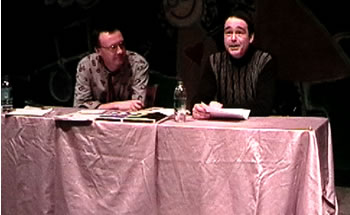The tale of the poodle is above all a story
of the vicissitudes of the life of a dog. You've got to let yourself be
clipped and combed by a hysteric, for example. Or serve as a slipper-carrier
for a master with Stink-Foot.
The material history of the poodle is
that of the transformation of a hunting dog, a retriever which swims in
the water, and was first bred in Germany. Its name derives from the German
for a stretch of water, Pudel. Its vile transformation onto an
ornamental monstrosity was something achieved by the French - hence the
term "the French poodle". This mutation is the expression of an aesthetic
which tries to turn the poodle into a symbol of ultimate beauty at dog
shows. The poodle is judged by its "look". The poodle, Zappa has taught
us, is a divine creature, and therefore a mistake, an aberration, a catastrophe.
This story is told in "The Poodle Lecture", which can be found on volume
five of You Can't Do That On Stage Anymore. After His first two
mistakes - the creation of Man, and that of the Wo-man - God wanted to
create a regular dog, a Schnauzer, but he fucked up! The result of his
error, the poodle, is a misbeggotten travesty, whose long hair displeased
its mistress. She therefore decided to clip him, to make him more cute
and pleasing - more "mod". As an accomplice in the aesthetic fantasies
of his mistress, the poodle is therefore the aesthetic manifestation of
animal subjection: "Beauty knows no pain!". A perfectly docile animal,
the poodle allows itself to fulfill the apex of its figurative potential
with the aid of a variety of accessories: scissors, clippers, and of course
the ever-popular - hitherto unknown in Somers Town, but destined to become
a favourite item for the denizens of this area - zirkon-encusted tweezers.
Of course, the poodle is also valued as
a pet, and for the many little services it can supply. In The Negative
Dialectics of Poodle Play, Ben Watson observed that "Poodles seemed
to arrive with Overnite Sensation, but they had been around in
latent form before ... on the sleeve of Absolutely Free a dog collar
appears on an advertisment hoarding above the slogan 'BUY A FYDO fits
swell', a phrase which later evolved into the album title One Size
Fits All" (p. 235). With its accoutrements advertised all over American
cities, the dog has become a stake for vast and sinister commercial interests.
Zappa exposed the society of consumerism in one of his most outrageously
trivial pieces of dialogue. In "Eddie, Are You Kidding?" from Just
Another Band from LA, Mark Volman asks "Where can I get my poodle
clipped in Burbank?". To Bob Marshall, Zappa said "Everyone wants to save
the whale, but who cares about poodles?". Actually, the maufacturers of
scissors and other chic accessories for poodle-grooming are laughing all
the way to the bank: the poodle's has commercial potential.
Faithful companion reduced to a passive,
uncomprehending vehicle for various industrial products aimed at pets,
the dog is also the victim of uncontrolled experimentation. One example
is "Evelyn, A Modified Dog", who we meet in One Size Fits All.
In Them or Us [The Book] (pp. 155-8), we learn that Evelyn is a
collie belonging to Jimmy, a seven-year-old boy. His father, Barney, did
special effects on the last big Kiss tour, and claims to be "the most
important show business figure in the entire Southern Californian area".
His mother, Florence, used to sell cosmetic products to her neighbours
(something Captain Beefheart's mother did at one time). All four characters
- dog, Jimmy, Mom and Dad - have their heads and feet encased in canvas
bags like the Elephant Man - they're so monstrous they need to be kept
covered up. After using some fennel shampoo sold by Florence, they all
became "UGLY AS FUCK".
The pooodle is an object for laboratory
experiment, like the ponies of Them or Us [The Book] which a mad
professor places inside a space capsule which will explode in flight.
But the trials and tribulations of Evelyn don't stop there: having removed
its face-bag and using a cardboard tube, Barney makes the dog sniff an
ounce and a half of cocaine. The torture never stops for the dog-slave,
victim of Man and his instinct for domination.
This experimentation leaves no domain
of research untouched. It extends as well to sexual activities. Having
exhausted her aesthetic fantasies, the Wo-man decides to transform her
modified dog into a sexual partner, saying, in a lascivious manner:

